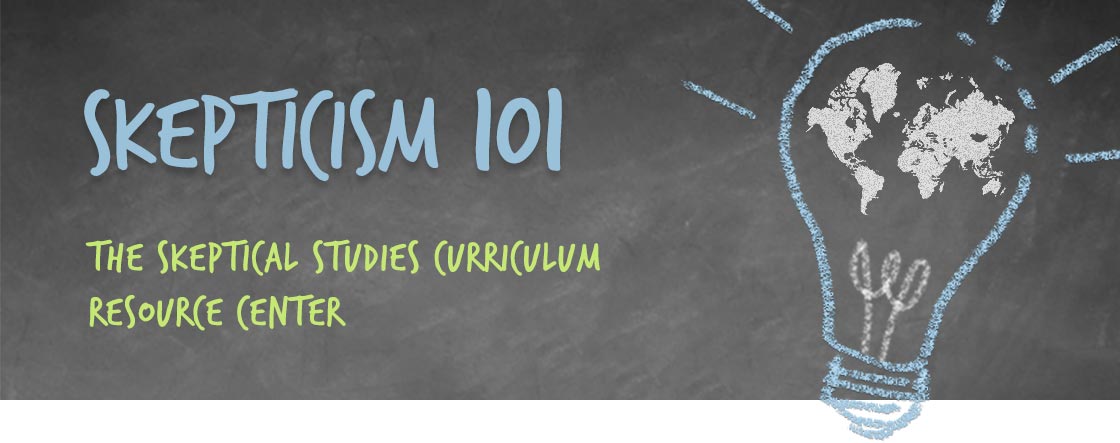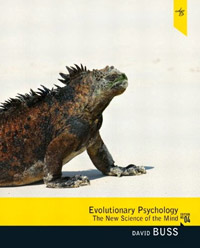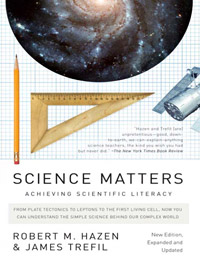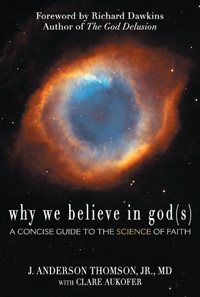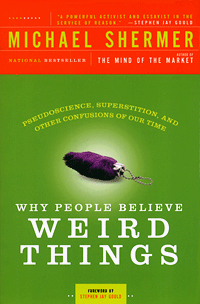You Are Browsing Resources on:
evolution and/or creationism
Dr. Michael Shermer continues the discussion of evolution and creationism, focusing on the history of the creationism movement and the four stages it has gone through: (1) Banning the teaching of evolution, (2) Demanding equal time for Genesis and Darwin, (3) Demanding equal time for creation-science and evolution-science, and (4) Intelligent Design theory. Shermer provides the legal, cultural, and political context for how and why creationism evolved over the 150 years since Darwin published On the Origin of Species in 1859, thereby providing a naturalistic account of life, ultimately displacing the creationist supernatural account. Finally, Shermer reviews the best arguments made by creationists and why they’re wrong.
Skepticism 101: How to Think Like a Scientist covers a wide range of topics, from critical thinking, reasoning, rationality, cognitive biases and how thinking goes wrong, and the scientific methods, to actual claims and whether or not there is any truth to them, e.g., ESP, ETIs, UFOs, astrology, channelling, psychics, creationism, Holocaust denial, and especially conspiracy theories and how to think about them.
If you missed Dr. Shermer’s previous Skepticism 101 lectures watch them now.
Dr. Michael Shermer takes viewers to the Galápagos Islands to retrace Darwin’s footsteps (literally — in 2006 Shermer and historian of science Frank Sulloway hiked and camped all over the first island Darwin visited) and show that, in fact, Darwin did not discover natural selection when he was there in September of 1835. He worked out his theory when he returned home, and Shermer shows exactly how Darwin did that, along with the story of the theory’s co-discoverer, Alfred Russel Wallace. Then Shermer outlines what, exactly, the theory of evolution explains, how it displaced the creationist model as the explanation for design in nature (wings, eyes, etc. as functional adaptations), and why so many people today still misunderstand the theory and how that sustained the creationist model.
Skepticism 101: How to Think Like a Scientist covers a wide range of topics, from critical thinking, reasoning, rationality, cognitive biases and how thinking goes wrong, and the scientific methods, to actual claims and whether or not there is any truth to them, e.g., ESP, ETIs, UFOs, astrology, channelling, psychics, creationism, Holocaust denial, and especially conspiracy theories and how to think about them.
If you missed Dr. Shermer’s previous Skepticism 101 lectures watch them now.
About the photograph above
Charles Darwin described of what he called the “craterized district” on San Cristóbal, Galápagos Islands thusly:
The entire surface of this part of the island seems to have been permeated, like a sieve, by the subterranean vapours: here and there the lava, whilst soft, has been blown into great bubbles; and in other parts, the tops of caverns similarly have fallen in, leaving circular pits with steep sides. From the regular form of the many craters, they gave to the country an artificial appearance, which vividly reminded me of those parts of Staffordshire, where the great iron-foundries are most numerous.
The photograph was taken on 21 June 2004 by Dr. Frank Sulloway. Darwin hiked this area in September, 1835.
Mentioned in this lecture
Myths. Conspiracy Theories. Illusory Correlation. Do these things have an evolutionary basis in common? What type of thinking enables conspiracy theorists to correlate ideas that in truth have nothing to do with each other? In his book, The Believing Brain, Michael Shermer refers to these types of thinking as patternicity — finding meaningful patterns in meaningless noise.
In this video project by Christopher Griffin, a senior Graphic Design student at the California College of the Arts (San Francisco), these pattern-seeking ideas are visually illustrated, as if diving head-first into the mind of a true believer.
This project was designed in Adobe After Effects and Maxon Cinema 4D, with assets built in Adobe Illustrator.
This PowerPoint is part of a course titled, “Science Skepticism & Weird Behavior.”
SCIENCE, THEORY, AND PARADIGM SHIFTS
There are three lectures in this series, they are intended to educate students about the nature of science and the power of natural explanations. This is accomplished through the concept of the Paradigm Shift. The discussion begins with non-scientific views of nature and then follows the development of scientific views and how/why they changed over many hundreds of years. This post concerns the second lecture in the series.
Examples of paradigm shifts covered in the lecture series include:
- the shift from supernatural to nature interpretations of comets.
- the shift from astrology (Ptolemaic) to astronomy (Copernican revolution).
- the development of Copernican cosmology to a synthesis called Newtonian physics.
- the shift from Newtonian physics into Relativity Theory.
Lecture 2 – PARADIGM SHIFT 2
This lecture introduces the concept of scientific paradigm shifts, the concept of empiricism, the concept of anomalies and the concept of synthesis. These concepts are discussed in the context of a paradigm shift called the Copernican and the Newtonian Revolutions.
DOWNLOAD THIS RESOURCE
(20.6 MB Powerpoint Presentation)
Lecture 1 – PARADIGM SHIFT 1
You can find the first lecture in the series here.
Lecture 3 – PARADIGM SHIFT 3
You can find the third lecture in the series here.
This course was taught at Chapman University during the spring 2013 semester as an undergraduate course.
Excerpt from Syllabus
This course addresses the evolutionary origins of morality, the developmental psychology of moral emotions, the historical course of moral development throughout the history of civilization, and the forces that have bent the arc of the moral universe toward truth, justice, freedom, and prosperity.
Students will look at how the arc of the moral universe bends toward truth, justice, freedom, and prosperity thanks to science the type of thinking that involves reason, rationality, empiricism, and skepticism. The Scientific Revolution led by Copernicus, Galileo, and Newton was so world-changing that thinkers in other fields consciously aimed at revolutionizing the social, political, and economic worlds using the same methods of science. This led to the Age of Reason and the Enlightenment, which in turn created the modern secular world of democracies, rights, justice, and liberty.
DOWNLOAD THIS RESOURCE
(209 kb PDF)
This course was taught at the University of Texas at El Paso during the spring 2013 semester.
Excerpt from Syllabus
This course is designed to introduce students to a variety of critical thinking skills and to encourage them to practice those skills in the context of evaluating popular claims, especially extraordinary claims about topics relevant to anthropology and archeology. It is intended for students who are attracted to the interesting topics identified with anthropology in the popular media, but the level of instruction assumes no prior experience in anthropology. Students will learn about the methods used to interpret the physical traces of behavior, and how to distinguish scientific arguments from pseudoscience and non-science. Lectures, readings and class exercises will examine a variety of non-scientific explanations for past and present events, such as UFOs and ancient astronauts, Bigfoot, pyramid power, Atlantis, creationism and intelligent design, the Book of Mormon, dowsing, climate change denial, and psychic archeology.
Does Bigfoot roam the mountains of Oregon, and do his cousins hang out in the Sacramento Mountains of southern New Mexico? Are they shape-shifters, or do they use wormholes to travel the time-space continuum? Are extraterrestrial aliens like the ones who crashed in Roswell, New Mexico silvers or greens? Is there really an exotic blood-sucking animal called chupacabra killing livestock in the southern U.S. and northern Mexico, or is it just a hairless raccoon? Should we believe Senator James Inhofe when he says that global climate change is a hoax? Is cell phone use harmful to your health? Do the Power Balance bracelets worn by Drew Brees and Kobe Bryant provide any real scientific advantage to athletes? Are modern humans related to ancient prehistoric peoples, or were we created in modern form? Is there reliable evidence to support the claims that psychics can reveal details about the past or make valid predictions about the future? Was planet earth really visited by ancient astronauts, and did they teach Egyptians how to build the pyramids? How can we know the answers to such questions? In fact, how can we know the truth about any claim? We are bombarded by information and claims all the time, and it is vitally important, now more than ever, that we be able to distinguish valid information and warranted conclusions from those that are not. How can we do this, especially when the claims involve events that occurred in the prehistoric past, were not witnessed by humans, or were not documented in written records?
DOWNLOAD THIS RESOURCE
(4 MB PDF)
This course was taught at the California State University, Northridge during the fall 2010 semester.
Excerpt from Syllabus
One of the characteristics of contemporary American popular discourse is a marked increase in irrationalism. Belief in the paranormal, pseudoscience, and millenialism is perhaps more prevalent than at any other time in the history of Western Civilization. This course seeks to test these beliefs through the application of rhetorical analysis and critical thinking to discourse advancing extraordinary claims.
Learning Goals
Upon successful completion of this course, the students will be able to:
- Identify extraordinary claims in popular discourse.
- Identify the types of appeals, including forms of reasoning and evidence, used to advance extraordinary claims in popular discourse.
- Assess the strength of rhetoric advancing extraordinary claims.
- Prepare critical analyses and refutations of rhetoric advancing extraordinary claims.
DOWNLOAD THIS RESOURCE
(118 kb PDF)
This book was required reading for the following course: “Evolution, Economics, and the Brain” taught by Michael Shermer during the spring 2011 and 2012 semesters.
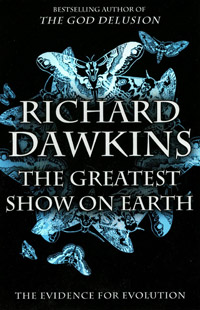
Richard Dawkins transformed our view of God in his blockbuster, The God Delusion, which sold more than 2 million copies in English alone. He revolutionized the way we see natural selection in the seminal bestseller The Selfish Gene. Now, he launches a fierce counterattack against proponents of “Intelligent Design” in his latest New York Times bestseller, The Greatest Show on Earth. “Intelligent Design” is being taught in our schools; educators are being asked to “teach the controversy” behind evolutionary theory. There is no controversy. Dawkins sifts through rich layers of scientific evidence—from living examples of natural selection to clues in the fossil record; from natural clocks that mark the vast epochs wherein evolution ran its course to the intricacies of developing embryos; from plate tectonics to molecular genetics—to make the airtight case that, “we find ourselves perched on one tiny twig in the midst of a blossoming and flourishing tree of life and it is no accident, but the direct consequence of evolution by non-random selection.” His unjaded passion for the natural world turns what might have been a negative argument, exposing the absurdities of the creationist position, into a positive offering to the reader: nothing less than a master’s vision of life, in all its splendor. —Amazon
BUY THIS BOOK
from Amazon
Richard Dawkins gave a lecture on this book at the California Institute of Technology.
BUY THE DVD
from Shop Skeptic
This book was required reading for the following course: “Evolution, Economics, and the Brain” taught by Michael Shermer during the spring 2011 and 2012 semesters.
Beginning with a historical introduction, the text logically progresses by discussing adaptive problems humans face and ends with a chapter showing how the new field of evolutionary psychology encompasses all branches of psychology. Each chapter is alive with the subjects that most occupy our minds: sex, mating, getting along, getting ahead, friends, enemies, and social hierarchies. Why is child abuse 40 times more prevalent among step-families than biologically intact families? Why, according to one study, did 75% of men but 0% of women consent to have sex with a complete stranger? Buss explores these intriguing quandaries with his vision of psychology in the new millennium as a new science of the mind. Anyone with an interest in the biological facets of human psychology will find this a fascinating read. —GoodReads
BUY THIS BOOK
from Amazon
This book was required reading for Thomas Holtz & John Merck’s course, “Science & Global Change Colloquium” taught at the University of Maryland during fall 2011.
Knowledge of the basic ideas and principles of science is fundamental to cultural literacy. But most books on science are often too obscure or too specialized to do the general reader much good.
Science Matters is a rare exception-a science book for the general reader that is informative enough to be a popular textbook for introductory courses in high school and college, and yet well-written enough to appeal to general readers uncomfortable with scientific jargon and complicated mathematics. And now, revised and expanded for the first time in nearly two decades, it is up-to-date, so that readers can enjoy Hazen and Trefil’s refreshingly accessible explanations of the most recent developments in science, from particle physics to biotechnology. —Amazon
BUY THIS BOOK
from Amazon
This book was required reading for Dr. Innes Mitchell’s course, “Perspectives on Atheism” taught at St. Edwards University during spring 2012.
In this groundbreaking work, J. Anderson Thomson, Jr., with Clare Aukofer, offers a succinct yet comprehensive study of how and why the human mind generates religious belief. Dr. Thomson, a highly regarded psychiatrist known for his studies of suicide terrorism, investigates the components and causes of religious belief in the same way any scientist would investigate the movement of astronomical bodies or the evolution of life over time, that is, as a purely natural phenomenon. Providing compelling evidence from cognitive psychology and the neurosciences, he presents an easily accessible and exceptionally convincing case that god(s) were created by man, not vice versa. With this volume, Dr. Thomson establishes himself as a must-read thinker and leading voice on the primacy of reason and science over superstition and religion.—Amazon
BUY THIS BOOK
from Amazon
These resources are from a Summer Youth Program for High School Students titled, “Brain Glitches” and taught by Diane Graft. You can find in-class exercises for this summer course here.
Our brain is the best tool we have for understanding the world, but our mental software has bugs. We have a better chance of sorting out the truth from the baloney if we understand the ways in which our brain works. The PowerPoints provided here are used to discuss many topics with students, including:
- Confirmation Bias
- Agency Detection and False Positives
- Anchoring Bias and the Decoy Effect
- Memory Failures/Filling in the Gaps
- Placebo Effect
- Sunk Cost Fallacy
- Backfire Effect
- Probability
- Type 1 & Type 2 Errors
Anchoring Bias PowerPoint Found Here:
DOWNLOAD THIS RESOURCE
(815 kb Powerpoint Presentation)
Confirmation Bias PowerPoint Found Here:
DOWNLOAD THIS RESOURCE
(1.8 MB Powerpoint Presentation)
Memory PowerPoint Found Here:
DOWNLOAD THIS RESOURCE
(622 kb Powerpoint Presentation)
The presentation explores the evolutionary basis for the creation and consumption of art in all forms. It discusses art’s adaptive function; as well as, its role in natural and sexual selection. The universality and evolutionary basis of aesthetic tastes in art is also discussed. This presentation was created by Amanda Limongi for Dr. Michael Shermer’s course, “Evolution, Economics & the Brain” taught at Claremont Graduate University during the spring 2012 semester.
DOWNLOAD THIS RESOURCE
(6.6 MB Powerpoint Presentation)
This book was required reading for the following courses: (1) “Skepticism 101: How to Think Like a Scientist Without Being a Geek” taught by Michael Shermer, (2) “Weird Science” taught by John Donovan, and (3) “Skepticism, Science, & the Paranormal” taught by Martin Bridgstock.
In this age of scientific enlightenment, many people still believe in mind reading, past-life regression theory, New Age hokum, and alien abduction. A no-holds-barred assault on popular superstitions and prejudices, Why People Believe Weird Things debunks these nonsensical claims and explores the very human reasons people find otherworldly phenomena, conspiracy theories, and cults so appealing. Michael Shermer takes on science luminaries like physicist Frank Tippler and others, who hide their spiritual beliefs behind the trappings of science.
Shermer, science historian and true crusader, also reveals the more dangerous side of such illogical thinking, including Holocaust denial, the recovered-memory movement, the satanic ritual abuse scare, and other modern crazes. Why People Believe Weird Things is an eye-opening resource for the most gullible among us and those who want to protect them.
BUY THIS BOOK
from Shop Skeptic
This course was taught at Claremont Graduate University during the spring 2012 semester.
Excerpt from Syllabus
Evolution, Economics, and the Brain is a doctoral-level Transdisciplinary Course designed to address large issues in which students employ knowledge and research protocols from many different disciplines to shed new light on specific problems. One of the books assigned—Steven Pinker’s The Better Angels of Our Nature—integrates evolution, history, anthropology, sociology, psychology, economics, and political science to explain a single phenomenon: the decline of violence. It is a model work in transdisciplinary integration.
A transdisciplinary and integrative overview of evolutionary theory, evolutionary economics, and neuroscience (“Evolution, Economics, and the Brain”) that includes a brief history and science of evolutionary theory, along with the evolution-creationism controversy and how it evolved in the context of American history and culture. As well, the application of evolutionary theory will be considered in its integration into psychology, anthropology, ethics, and economics. The course also includes an introduction to behavioral neuroscience and will focus on teaching students how new findings in the brain sciences can inform their work in the social sciences and humanities. For example: How reward acquisition is affected by risk; Why humans are typically risk-averse and when they are not; Hyperbolic discounting of future rewards; How interpersonal trust is built and maintained; How “rational” vs. “irrational” decisions are made; The basis for cooperation and aggression; The reason people punish others; The role of hormones in decisions; The basis for social norms or ethics; The sense of justice; The basis for love and hate and how these effect decisions; War and peace; Human nature; The decline of violence; The humanitarian and rights movements; and more.
DOWNLOAD THIS RESOURCE
(338 kb PDF)
This PowerPoint is part of a course titled, “Perspectives on Atheism“.
This presentation begins by correlating high levels of religious belief with high levels of scientific illiteracy in the United States. Based largely on J. Anderson Thomson’s book, Why We Believe in Gods, this presentation looks at the ways in which religious belief piggybacks on cognitive functions evolved for satisfying other purposes (social cognition) using examples from Thomson’s book.
DOWNLOAD THIS RESOURCE
(85 MB Powerpoint Presentation)
This PowerPoint is part of a course titled, “Perspectives on Atheism“.
This presentation begins by addressing mainstream misperceptions and fears regarding Evolution. Eugenie C. Scott’s “Three Pillars” of criticism leveled at the scientific theory of evolution are discussed. The landmark Dover ruling is examined before we experience more adventures with the Texas School Board. The presentation concludes with a brief film on the 1925 Scopes Trial from the PBS documentary God in America.
DOWNLOAD THIS RESOURCE
(94 MB Powerpoint Presentation)
This course was taught at Portland State University.
Excerpt from Syllabus
This course is a systematic examination and analysis of atheism. It is primarily focused upon understanding contemporary secular arguments regarding religion and faith-based belief systems. It is secondarily focused upon exploring what secularism means for metaphysics, epistemology, morality, politics, aesthetics, etc.
Learning Goals
After successfully completing this course students should be able to:
- Use critical thinking skills to analyze arguments for God’s existence
- Examine and evaluate counterarguments
- Understand secular responses to faith-based morality, epistemology and metaphysics
- Investigate the role evidence ought to play in belief formation
- Examine basic logical fallacies and their application
- Explore writings and lectures of contemporary atheist thinkers
- Research 1) A specific argument for God’s existence, and 2) The counter to that argument
- Evaluate, Present and Defend findings to the class
- Address questions of textual exegesis and interpretation and their relevance to religious doctrine and belief
- Explore the controversy surrounding “the new atheists”
- Engage debates from leading religious and secular thinkers regarding God’s existence
- Explore different faith traditions by visiting local religious services and then sharing your experiences with classmates
- Examine Christian epistemology and warrant through writings of Christian thinkers
- Reflect on learning experience and articulate those experiences to peers
- Develop teamwork skills by working with fellow classmates to analyze complicated epistemological problems
- Engage controversial ideas and attempt to come to a consensus
- Empower themselves with the tools to navigate questions about faith, God and the meaning of life
DOWNLOAD THIS RESOURCE
(252 kb PDF)
This course was taught at Griffith University during the spring 2011 semester.
Excerpt from Syllabus
Paranormal beliefs are important, widespread and yet rarely studied. The analysis of those beliefs is both valuable in itself and useful in developing critical and analytical skills. Since both skepticism and the paranormal are defined in relation to science, and are often strongly influenced by science, some elucidation of the nature of science and of its position in society is required. Modern skepticism the science-inspired study of paranormal claims relates both to science and to the paranormal, and seeks to influence media coverage of these issues.
The course aims to elucidate the nature of the three terms in the title and, through the lectures and the seminars, to enable the students to evaluate paranormal claims in skeptical terms. Both the seminars and the take-home exam encourage students to apply skeptical concepts to the paranormal, and to arrive at their own conclusions. The multiple choice examination encourages broad comprehension of key concepts.
Learning Goals
After successfully completing this course students should be able to:
- Understand the nature of skepticism, science and the paranormal and their places in western societies, as shown in an ability to outline their key attributes.
- Understand the intellectual tools of modern skepticism, their ethical dimensions and their applicability to paranormal claims, as shown by an ability to outline these and instance their application to specific cases.
- Have the ability to apply skeptical criteria to selected paranormal and related claims.
- Have the capacity to present the results of analysis in well-structured and logical form.
DOWNLOAD THIS RESOURCE
(283 kb PDF)
This course was taught at the University of Findlay during the fall 2011 semester.
Excerpt from Syllabus
This course examines the key issues associated with the scientific study of critical thinking. Although it’s common to see courses on critical thinking in many domains (e.g. education & philosophy) the scientific examination of what critical thinking is and how it relates to problem solving is exclusively an advanced topic in cognitive science. Cognitive science is concerned with the study of the “thinking mind” and when we talk about “critical thinking” we base our examination on the hypothesis that while it’s true that everyone “thinks” it’s not true that everyone “thinks well.” At the core of this class is the idea that we can all fall prey to bad thinking strategies. In this course, students will learn how to be critical thinkers when dealing with a variety of situations, as well as learn how to tell the difference between science and pseudoscience. Students will focus primarily on how to think about weird situations, but if they can master the skills needed to effectively evaluate strange phenomena (e.g. UFOs) students can easily apply these skills to less bizarre situations (e.g. Will eating “Cheerios” really help lower cholesterol?). By the conclusion of this course students should be able to find answers for themselves (because everyone knows “The Truth Is Out There”) and with good critical thinking skills they will be more likely to find it.
Learning Goals
Upon completion of this course students will be able to:
- Demonstrate scientific reading, and writing skills.
- Apply the science of critical thinking to unique situations.
- Discuss specific critical thinking & problem solving topics in depth.
- Understand the biological bases of behavior and mental processes.
- Use theories to explain and predict behavior and mental processes.
DOWNLOAD THIS RESOURCE
(312 kb PDF)
NEXT PAGE →

